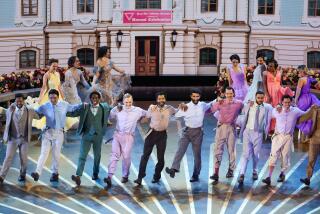Music and Dance Reviews : India’s Bharata Natyam at the Japan America
- Share via
Though tracing its origins to before 300 BC, Bharata Natyam, the classical dance idiom of southern India, is nonetheless an evolving art form. One major area of recent experimentation has been in going beyond the traditional restriction to a solo dancer--who fluidly interprets a number of characters in a single piece--to introducing several dancers on stage at once.
The Dhananjayan family--Padmashri V.P., Shanta and their 14-year-old son Satyajit--provided impressive examples of both formats Saturday at the Japan America Theatre. The Dhananjayans are from India; their concert was sponsored by the local Shakti Foundation for the Performing Arts.
The two elder Dhananjayans actually found a creative, easy link between traditional and new in the question-and-answer format of the hourlong dance drama, “Shiva Shakti Vel.” This allowed a sequence of brilliant solos to flow naturally one after one another as Parvati questions her consort, Lord Shiva, about cosmic matters.
Those issues resolved, the two found renewed bliss in passages of fluent mirror-image symmetries, followed by a sequence leading to the birth of a son who would help gods and mankind slay ignorance.
Still, it was Dhananjayan’s solo depiction of Shiva taming the Ganga (a.k.a. Ganges) by letting the river flow through his hair that drew a spontaneous ovation from the largely Indian audience.
The program had opened with a series of solo works, heavily weighted in the direction of “expressive” dance, in which mime and gesture predominated in interpreting a text. More movement-involved works were danced by the already-accomplished and still-promising young Satyajit.
Dhananjayan gave informative spoken introductions to each of the dances, regularly indicating key mime or gestural motifs.
Providing excellent musical support were vocalist Reji George, flutist R. Gopinath and drummer N. D. Kannan.
More to Read
The biggest entertainment stories
Get our big stories about Hollywood, film, television, music, arts, culture and more right in your inbox as soon as they publish.
You may occasionally receive promotional content from the Los Angeles Times.








